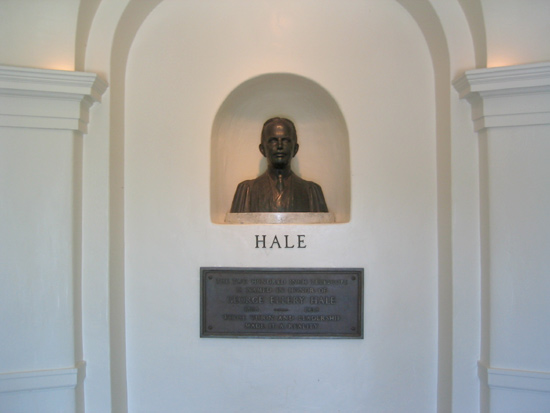

I recently found myself in Los Angeles on a trip with a day to spare. I had planned on visiting the Griffith Observatory; but wouldn’t you know it, the place was closed for a three year renovation. A quick check of Cal Tech’s website and I find the famous Palomar Observatory is open to visitors. Plan on three hours of non-rush hour driving to get from LA to Palomar Observatory. One exits I-15 southeast of LA on to CA76, a two-lane blacktop through a rural mountain valley, and finally up a 3500-foot climb called S6. For a mid-westerner, the trip to the top of Palomar Mountain might as well have been a trip to Mars. With so much foreign flora and scenic overlooks I find myself stopping to admire the views along the roadside and the views miles away to the next mountain ridge. Strange plants, many in full bloom in early July, beckon me to stop and photograph them. I am reminded to put the car into park, set the brake, and turn the wheel to assure the rental car doesn’t end up over the side of a cliff. The trip up S6 took twice as long as it could have. Half the fun, after all, is getting there.
Continuing up the south side of Palomar mountain one notices several “Caution Dairy Cow” signs, although none are seen. It’s no surprise. The absurdity of having dairy cows on the side of a mountain that requires a 7% white-knuckle switch back road to navigate its summit is lost on me. Perhaps the road commission was out a more appropriate warning signs.

The observatory shares the summit with the Cleveland National Forest. Once on the mountaintop, you notice that the forest has changed from a mostly deciduous forest, on the south side of the mountain, to a tall redwood, cedar, and conifer forest on its north side. About 20% of the trees appear to have succumb to a blight and are standing deadwood, many with their needles still attached. All at once you are face to face with the impending national forest fire dilemma. Around a bend in the road and there it is, shining brightly in the reflected sun light off its titanium white dome. The dome of the Hale 200-inch telescope is just like you imagined it. Named after the astronomer, who promoted, no, perhaps goaded the astronomy community to construct this telescope during the mid 30s; George Ellery Hale never lived to see the observatory completed. Nestled in a high mountain plateau, Palomar Observatory looks smallish until you realize that you are probably still a mile away. Signs to the Palomar property shuffle you to a generous paved parking lot. Off in the distance is the observatory. All of a sudden you begin to take in the size of the signature dome. Those ants around the outside are people!
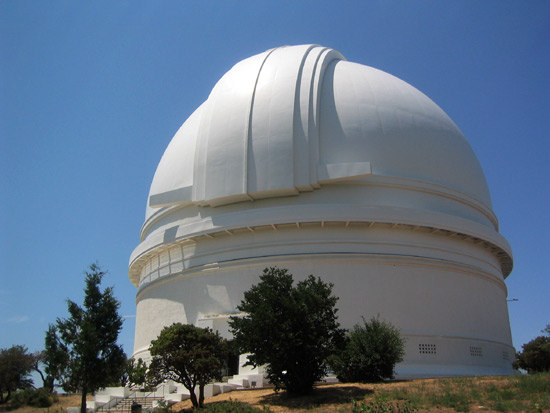
A sign cautions you to stay on the path or the rattlesnakes will get you. First stop is a nice little museum and gift shop. The museum is designed in the vernacular of the mid-century modern with a touch of the southwest that complements the dome nicely. In the center of the one room museum is a terrazzo covered full size mock up of the 200-inch mirror. Man, this mirror is bigger than my first apartment. Around the perimeter of the space are astro photos, many taken through the Hale telescope. I make a mental note to stop by later to visit the gift shop; then I am out the door on the short path to the dome. This amateur has come to Mecca.
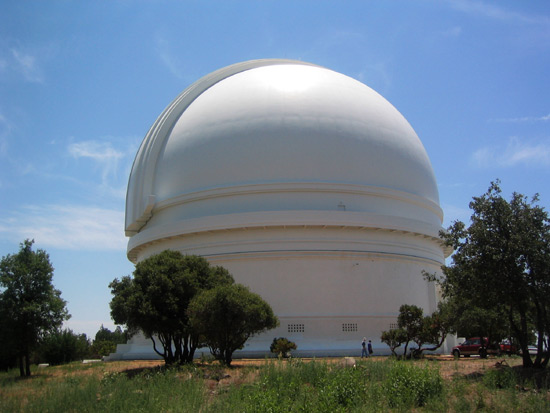
A short walk to the observatory is an exercise in proportions. This dome is HUGE! Yet when one approaches the base of the observatory there is a sense of human scale brought on by the strong horizontal line of the catwalk around the outside of the dome. The structure sits on a slightly elevated mound. A set of stairs must be ascended as one would ascend the steps of a cathedral or a classically designed courthouse to enter the building. The architecture of the observatory doesn’t look dated or out of place when compared to today’s style. Its simple design compliments the natural site of its mountaintop plateau. One gets the feeling that nothing out of the ordinary was embellished on the observatory design and setting. The half-century design suggests that the mission here is the science of the exploration of the universe. A Herculean task to be performed in a bold and mighty structure. Cal Tech has maintained this 50 year-old structure quite nicely.
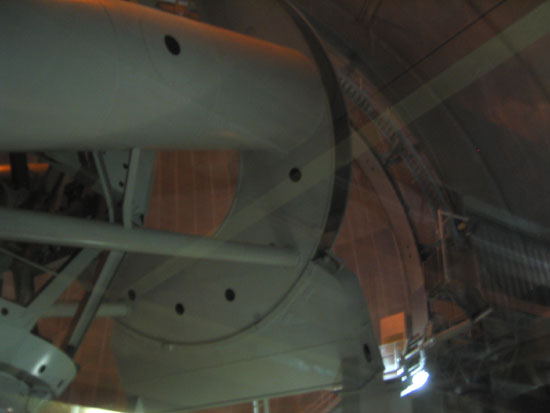
The exterior dimensions of the observatory are 135 feet high by 137 feet wide, very similar to the Roman Pantheon. Its 4-foot steel and aluminum double wall construction weighs in at 1,000 tons. Two 125-ton shutters form the slit. The dome rotates on a set of double tracks supported on 32 trucks that remind one of little railroad carriages. Upon entering the observatory’s front door one sees a ceremonial bust of George Hale sitting in a niche opposing the entrance, almost as if keeping an eye on all who enter his observatory. A short climb up two flights of stairs (past the toilets that famous observers of the past must have visited. Thanks Fred) and you are standing on the observatory floor along side the famous 200-inch, albeit separated from the scope itself by a glazed curtain walled visitors gallery. The inside of the building is purposely separated from the visitors, not just for reasons of security, but so as to maintain climatic conditions expected for the nighttime observing run. Lighting is kept to a minimum and air conditioning keeps the hot and humid Los Angles basin environment at bay. Observatory staff are busy mounting the night’s array of electronic detectors aided by a nifty little platform lift that rises from out of nowhere from the observatory floor. All this is available to the visitor as a form of silent entertainment from the gallery.
The construction of the observatory structure was started in 1936 and was completed a short two years later with help from some Cal Tech grads who helped pour the foundations. The telescope structure is a classic split ring, a horseshoe design with the optical tube assembly comprised of opposing serrurier trusses. The mirror mount unitizes an oil flotation solution. The 200-inch mirror, that looked so massive in the museum mock up, is almost lost sitting on the telescope assembly while the telescope structure sits on the observatory floor with room to spare inside the massive dome.
The telescope was constructed at east coast shipyards because there was no better place to fabricate and assemble the large steel plates that are used for each component of the scope. The US Navy helped escort the telescope components through the Panama Canal to the coast of California. Rumor has it the paint scheme is battle ship gray because that’s the color you find in a shipyard.
Mirror fabrication took place from 1934 to 1936. The primary was to have been made from fused quartz but the caster was unable to make such a large mirror after spending $1M trying. Hale convinced Corning Glass Works to construct the blank from Pyrex, a new low expansion material. After the second attempt an acceptable blank was made. A year was required just to cool the casting down. In 1936 the mirror was shipped across the country by rail car to Pasadena for grinding and figuring. Rough grinding removed 10,000 pounds of material from the blank. From 1941 to 1945 the work stopped as the nation turned its efforts to the war. In September of 1945 mirror figuring began again and by 1948 the observatory became operational.
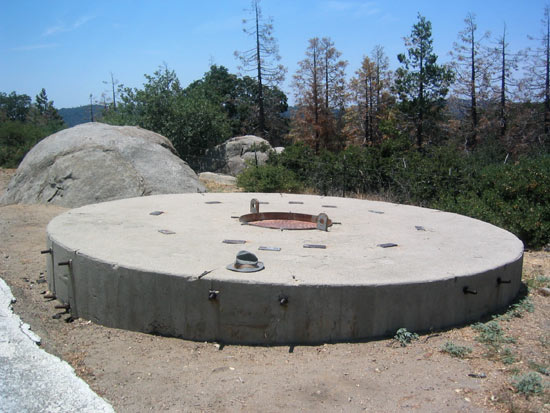
Upon exiting the dome, it’s a quick walk around the observatory, and then it’s off to the gift shop for some astronomical shopping therapy. But before that, I noticed, lying rejected on the ground, the spent concrete counterweight used in place of the mirror during construction to tweak the telescope’s movement. No mention of the contribution of Russell W. Porter to the development of the “Glass Giant,” as the 200-inch telescope was known during its development, although poster reproductions of his drawings are on prominent display in the gift shop. Russell Porter was a kind of Renaissance man of his time. Trained as an architect, an experienced arctic explorer, machining engineer, and founder of Stelafane, Hale enlisted his help in the development of the 200-inch. His hand drawn cutaway views of the telescope components and dome help decipher the complicated mechanisms that made the telescope buildable in the days before computer aided design.
The last note of interest unfortunately is a sad and familiar one. Light pollution from the San Diego megalopolis has reduced the 200-inch scope light grasp to that of a 140-incher. Prospects for any relief appear limited as the march of new residential developments from LA and San Diego appear to be in the process of colliding with the foothills leading to Palomar Mountain.
While packing up the camera I am already having pleasant memories and I haven’t even left the mountain. Perhaps I will need to find myself on another trip to distant city with a day to spare and an observatory to visit. With so many observatories, I just have to make the time.
All the photos on this page were taken by Christopher Sarnecki on his trip to the Palomar Observatory.